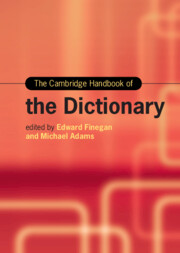Book contents
- The Cambridge Handbook of the Dictionary
- Cambridge Handbooks in Language and Linguistics
- The Cambridge Handbook of the Dictionary
- Copyright page
- Contents
- Figures
- Tables
- Contributors
- Acknowledgments
- Introduction
- Part I Types of Dictionaries
- Part II Dictionaries as Books
- Part III Dictionaries and Ideology
- Part IV Dictionaries and Domains of Use
- Part V The Business of Dictionaries
- Chapter 27 Organizing Dictionary Projects
- Chapter 28 Editing Dictionaries
- Chapter 29 Publishing the Dictionary: The Business Side of the Business
- Chapter 30 Legal and Ethical Issues in Dictionary-Making
- Part VI The Future of Dictionaries
- References: Dictionaries
- References: Secondary Works
- Index
Chapter 28 - Editing Dictionaries
from Part V - The Business of Dictionaries
Published online by Cambridge University Press: 19 October 2024
- The Cambridge Handbook of the Dictionary
- Cambridge Handbooks in Language and Linguistics
- The Cambridge Handbook of the Dictionary
- Copyright page
- Contents
- Figures
- Tables
- Contributors
- Acknowledgments
- Introduction
- Part I Types of Dictionaries
- Part II Dictionaries as Books
- Part III Dictionaries and Ideology
- Part IV Dictionaries and Domains of Use
- Part V The Business of Dictionaries
- Chapter 27 Organizing Dictionary Projects
- Chapter 28 Editing Dictionaries
- Chapter 29 Publishing the Dictionary: The Business Side of the Business
- Chapter 30 Legal and Ethical Issues in Dictionary-Making
- Part VI The Future of Dictionaries
- References: Dictionaries
- References: Secondary Works
- Index
Summary
This chapter provides an overview of the process of conceiving, researching, editing, and publishing dictionaries, both synchronic (or commercial) and historical. Discussed methods and tools for making dictionaries range from traditional hand-copying of citations from print books and paper-and-pencil editing to sophisticated electronic technologies like databases, corpora, concordances, and networked editing software. The chapter shows how editorial conception of the needs and sophistication of the end user largely determines the dictionary’s length and headword list as well as the format, defining style, and level of detail in entries. The chapter goes on to examine how the pressures of commercial publishing, with its looming deadlines and pressing need to recoup investment by profits from sales, affect the scope of dictionaries and the amount of time editors can devote to a project, and how these pressures differ from those affecting longer-trajectory, typically grant-funded historical dictionaries. Assessing the consequent challenges for managing and motivating people working in these two very different situations, what may be the most important factor in a project’s success, concludes the survey of dictionary editing.
Keywords
- Type
- Chapter
- Information
- The Cambridge Handbook of the Dictionary , pp. 562 - 592Publisher: Cambridge University PressPrint publication year: 2024

